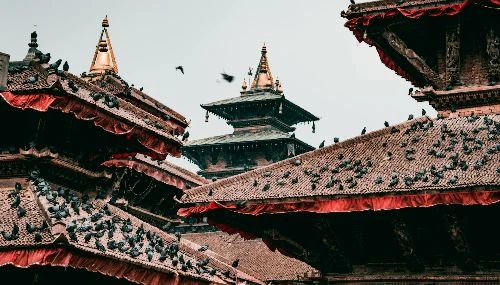Manaslu Trekking Difficulty is a topic that concerns most trekkers aiming for the majestic Manaslu region. First things first, the overall trip is moderately challenging. Some advise that only trekkers with prior experience trekking to 4,000m+ altitudes take on this challenge.
However, it’s not like the region is unwelcoming to first-timers. With good planning and advice, you can finish this journey successfully.
Nevertheless, you should know that the journey requires long hours of trekking through challenging terrain. The total trail length is 177 km, and you’ll reach the highest altitude of 5,106 m at Larke Pass.
Trekking days can stretch to as long as 9 hours of (breaks included) treading through forests, uneven terrain, and sloppy/icy pathways.
Because this region is thankfully still in its natural state and not commercialized like the Everest Region, one drawback is the comparable unavailability of services. You will stay at modest teahouses and savor Nepali and Tibetan-styled foods.
The staple trekker’s diet generally includes the classic Nepalese Dat Bhat (Rich, Pulses, and Curry) and Tibetan noodles.
Additionally, weather and altitude add to the Manaslu Trekking challenge like in all high-altitude trek routes. You should be careful of altitude sickness and prepare to combat the mountain cold, especially during mornings and nights.
Weather and temperatures further add to the challenges. Depending on the season, time of day, and location, temperatures along the trail can range from -6°C to 22°C.
Well, this trek isn’t a piece of cake–it’s tough. In the following sections, we'll delve deeper into the difficulties of the trek and give valuable tips to help you minimize these challenges and make the most of your Manaslu experience.
Looking for an easier trek in Nepal instead? Check out our expert-compiled list of the best 5 day treks in Nepal.
Elevation and Altitude Sickness
The elevation is one of the major factors in making the Manaslu Circuit Trek difficult, particularly due to the significant altitude gain throughout the journey. The elevation is just 730 meters at Soti Khola as you start, but it’s not long before you climb higher.
With each step forward, the air grows thinner, the temperature colder and the altitude higher.
The biggest challenge comes at the Larkya La Pass, which reaches a staggering 5,160 meters above sea level.
Trip Difficulty Grade | Moderately Challenging |
Trail Length | 177 km (110 miles) |
Terrain | Rugged, Off-the-Beaten-Path, Sloppy and icy at some places |
Altitude Range | 700m to 5135m |
Temperature Range | -6°C to 22°C |
Daily Trekking Time | 4 to 9 hours |
Climbing so high comes with risks, especially altitude sickness making you feel terrible–headaches, feeling out of breath, and nausea.
To stay safe, go slow and let your body adjust to the altitude. Acclimatization is a must. Drink plenty of water to stay hydrated, take breaks to rest, and get enough sleep.

Remote Location and Rugged Terrain
Another major factor that makes the trek to Manaslu difficult is its remote location and rugged, off-the-beaten path, sloppy, and icy (in some places) terrain.
The trekking route passes through mountainous terrain prone to landslides, and other natural hazards, especially during the monsoon season.
Unlike the easier-to-reach treks, there’s no direct flight from Kathmandu to Manaslu. Instead, you’ll have to hop on a bumpy bus/jeep ride to the starting point of the trek Soti Khola which is 140 km from Kathmandu. The drive will make even the bravest souls hold onto their seats tight.
And once you’ve survived the journey to Soti Khola, get ready to face some serious challenges–narrow cliffs, rocky terrain, and rivers that you’ll need to cross sometimes with nothing but a shaky bridge to rely on.
You’ll be trekking through some seriously remote areas, where it’s just you, the mountains, and maybe a little wildlife.
But it is all worth it. Imagine trekking through untouched wilderness, with nothing but towering mountains and beautiful waterfalls. It’s like something out of a dream.

Trekking Hours, Distance, and Duration
Trekking hours, distance, and duration with the challenging terrain and high altitude make this trip a formidable adventure.
The trail length spans approximately 177 kilometers (110 miles) over a 14 to 17-day itinerary, requiring you to walk for 11 to 13 days. Daily trekking time is 4 to 9 hours.
Not to mention, the rugged terrain and high altitude make each day’s trek a formidable challenge.
One of the initial hurdles met on the trail is getting through the steep Budhi Gandaki Gorge. You’ll face many uphill and downhill sections where you’ll have to trek for 5 to 6 hours.
But the toughest part is crossing the Larkya La Pass where you’ll have to trek for 10 hours. This pass is the most challenging part of the trek, with a tough climb, often through snowy and icy terrain.
It requires not only physical fitness but also mental resilience and careful acclimatization to overcome the trek’s difficulties and fully immerse in the breathtaking beauty of the Manaslu region.
Accommodation and Meals
Luxury isn’t on the menu in these trails. The services along the trail are more about providing the essentials rather than pampering you with lavish comforts.
You’ll be staying in teahouses and guest houses run by the locals themselves. Don’t expect fancy room services or soft and comfy bedding. You’ll get a pillow and a blanket, but it’s wise to bring along your trusty sleeping bag for added warmth and comfort.
Rooms typically have two single beds so you’ll likely be sharing your space. Bathrooms are shared too. While squat toilets are more common, you’ll rarely find Western-style toilets.
As for the meals, the menu is relatively limited compared to more developed trekking trails in Nepal. However, if you love Nepalese and Tibetan flavors, you are in for a treat.
Dal Bhat, a filling dish with rice, lentils, curry, and more is a staple that will keep you fueled for the journey ahead. Tibetan noodles, bread, and momo dumplings are also popular options.
While traditional Nepali and Tibetan dishes dominate the menu, you’ll still find some Western comforts like pizza, pasta, and sandwiches at some hotels.
Temperatures and Weather
Above 5,000 meters(16,000 feet), in Manaslu, you’ll find snow all year round. This area will have heavy rain and snow, with an average of 1,900 millimeters (75 inches) of rain each year. Most of this rain falls during the monsoon season, from June to September.
Likewise, the temperatures vary depending on where you are. In the warm subtropical zone, summers can be hot, around 31–34 °C (88–93 °F), and winters cool down to 8–13 °C (46–55 °F).
In the temperate zone, summers are more pleasant, around 22–25 °C (72–77 °F), while winters can get quite cold, dropping to −2–6 °C (28–43 °F), with snow and frost.
In the subalpine zone, from December to May, it usually snows, and the average temperature is 6–10 °C (43–50 °F).
As you know one of the biggest hurdles you’ll face is the unpredictable weather and temperatures. So, choose the best time that suits you well and gives you a comfortable journey.

Important Tips to Prepare for Your Manaslu Trek
While the trek to Manaslu presents unparalleled beauty, it’s not without its challenges. However, you can minimize the difficulty and fully enjoy the trip with the right preparation and approach. Here are tips to help you make the most of your Manaslu Trek.
Choose the Best Season
By timing your trek right, you’ll not only avoid harsh weather but also witness nature’s awe-inspiring wonders, minimizing any potential difficulties along the way. Opt for either the spring or autumn season which offers the best weather for trekking in the Manaslu region.
Improve Your Fitness Level
The Manaslu Trek demands a good level of fitness and endurance. Prepare your body for the challenges ahead by following a fitness regimen that includes a mix of cardio, strength training, and flexibility exercises. Start training at least 3 to 4 months beforehand.
Additionally, don’t forget a pre-trek health checkup to ensure you’re physically prepared for the trek.
Mental preparation is just as important. Imagine yourself effortlessly overcoming obstacles. Foster a positive mindset that will carry you through even the toughest stretches of the trail.
Pack The Right Gear
Your gear is your lifeline on the trail so you must pack wisely. Make sure to pack essentials such as travel documents, warm and comfortable clothes, good quality footwear, sleeping gear, and a comprehensive first aid kit.
For a comprehensive packing list tailored specially for the Manaslu trek, check out our blog: Ultimate Packing List for Manaslu
Hire Porters
Carrying a heavy backup through a challenging trekking trail can be exhausting. So consider hiring a porter who will effortlessly carry the bulk of your gear while you’ll only have to carry a light daypack on your shoulders.
You’ll not only lighten your load but also support the local economy–a win-win situation that allows you to enjoy the trek without the burden of a heavy pack.
Acclimatization & Proper Hydration
As you ascend to higher altitudes, acclimatization is a must. Take your time to adjust to the changing height and conditions by gradually gaining altitude and allowing your body to acclimate.
Stay properly hydrated by drinking plenty of water throughout the day. Also, sleep at a lower altitude than the highest point you reached during the day to aid in acclimatization. Trek at a slow pace and listen to your body to minimize the risk of altitude sickness.
With these tips in mind, you’re good to trek through the majestic landscapes of the Manaslu region.


.webp)

